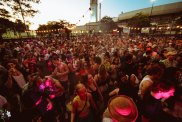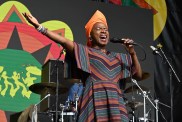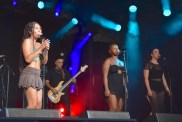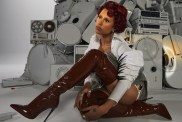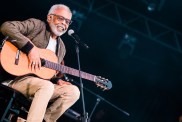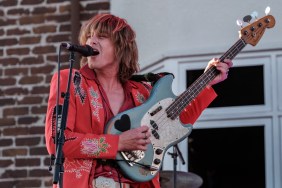Sitting on an Opera House Forecourt step is like perching yourself on the knee of a giant. Our Utzon-designed expressionist darling remains one of the largest, most recognisable, most profitable music venues in the world, a cultural gatekeeper looming over Sydney’s entrance at Circular Quay.
The Sydney Symphony Orchestra’s recent performance of Beethoven’s Ninth Symphony, the very same piece which opened the Opera House in 1973, now seems an almost obligatory 40th anniversary tribute to this behemoth’s heritage. Nowadays, the world-famous venue is slowly chipping away at its slightly mothballed image, eroding the colossus of past sensibilities and emerging as a somewhat more welcoming beast.
Speaking with Ben Marshall, head of contemporary music at the Sydney Opera House, his passion for the venue’s vintage decor and for music in general is clear, and it complements his warm hybrid Australian-English accent. “I think it’s lovely to acknowledge the moment that the Opera House was born in, and that it hasn’t come unmoored from its original founding principals,” he says.
It’s those principles, though, which Marshall has been tasked with subverting––as tastefully as possible, and with a minimum of fuss, of course. A noticeable artistic reinvigoration over the last five years has seen the venue accommodate acts as disparate and modern as trip-hop idols Massive Attack, New Zealand’s “fourth-most-popular folk parody duo” Flight of the Conchords, and Japanese noise rockers Boris.
Addressing traditional expectations whilst presenting a fresh-face sounds like a difficult position to say the least, but Marshall believes the Sydney Opera House remains an arts hub seeking foremost to reflect the cultural aspirations of contemporary society. It’s a mindset which holds firm to the Victorian values on which the venue was established.
“Throughout history, what that generally has meant is programming — and rightly so — classical music, opera, theatre, ballet and dance,” he says. “However, what we’ve seen is an explosion of very interesting, very ambitious contemporary music, and for us to completely fulfill the role of the building, we feel that artists like Nick Cave or Bon Iver or Fleet Foxes do represent the cultural aspirations of the society in which the Opera House finds itself today.”
So what are these cultural aspirations? According to Marshall, “Complexity, ambition, virtuosity, a level of detail, something to say, and an emotional resonance.” In just under 12 months, he has attracted a plethora of artists who embody all these characteristics to the Music at the House series, including visits from The National, Flying Lotus and Grizzly Bear in the coming months.
Watch: Empire Of The Sun – DNA (Live At The Sydney Opera House)
When discussing how he compiles the contemporary musical program, Marshall too acknowledges the venue as if it were a sentient, autonomous being, actively vetting all potential performances. “It’s very much what works for the building,” he says, “what the building’s priorities are, whether the building can add something to a certain sort of music… What we try and do with contemporary music programming is reflect the values of the building and the nature of the building as it applies to all art forms.”
Jørn Utzon’s original architectural plans positioned the House’s Concert Hall as a multi-purpose venue. Yet, when he left the project after much media and political scrutiny, the new panel of architects and engineers sought to produce something which best suited choral and orchestral works.
Immediately after the House opened in 1973, the generous arts funding of the Whitlam Labor government meant the venue hosted symphonies, chamber music, pop concerts, and even a boxing match which ended in an all-out brawl. But this diversity was slowly homogenised in the following decades. “It used to be quite hard to get an act into the Opera House,” Marshall confesses. “You just weren’t sure what the priorities of the building were, who to speak to, what they looked for in an act.”
In his time in the industry (he set up the touring division of indie label Inertia Music in a previous career) Marshall has seen the before and after shots of music at the House, as it shifted from being “a sort of orbiting space station” to finally establishing itself as part of the contemporary Australian music industry.
Nonetheless, the Opera House has always stood as an avenue to culture, a place where the value of art is judged. When I suggest to Marshall that programming the Opera House is still an exercise in high-art objectification, he reiterates the need for quality, and for the music itself to highlight the venue’s own qualities as an affective musical space.
“I don’t divide what we program into high and low art,” he counters. “There’s a lot of great art made in rock and roll that just should be in standing rooms and isn’t quite right for a seated venue. That’s what we look for, besides the quality of the art — it’s what’s right for the room. It has certain strengths and weaknesses, and we try and program to play to those strengths, which allows us to add something to the artist’s performance,” he tells me.
In other words, reverence is not essential, but the giant must still be allowed to speak. The shifting applications of the venue’s design and the process of change has left us with a venue which can highlight and accentuate the subtleties of certain genres, from the indie-folk of Sufjan Stevens, to the dark electronics of James Blake and The Knife, an act Marshall says he’d “love to have” when the band are ready.
Marshall recalls the time before the Mercury Prize-winning Blake’s sold-out July shows had even been booked. “For a second we asked, ‘My gosh, are we allowed to do that in there?'” It’s indicative of how the Opera House can still push the limits of what’s musically appropriate — playing with the space by making you want to move, even though you have minimal ability to do so. You end up “just riveted in your chair,” as Marshall puts it.
Over the next 40 years, Marshall hopes that the Opera House will “broaden its embrace of excellence” and become a place where even more people feel they’re welcome, challenging the popular sentiment during the House’s early years — that what was seen was more important than how many people saw it. “If it can just stay on track with its expansiveness and generosity whilst maintaining its level of excellence, it’ll have more and more influence and reach in the local community and in the cultural conversation with Australia.”
Music At The House continues this summer, with Nile Rodgers and Chic set to perform this Saturday, 7th December. For a full list of upcoming events, check our Music At The House Feed.
(Additional writing by James Arnold-Garvey)


